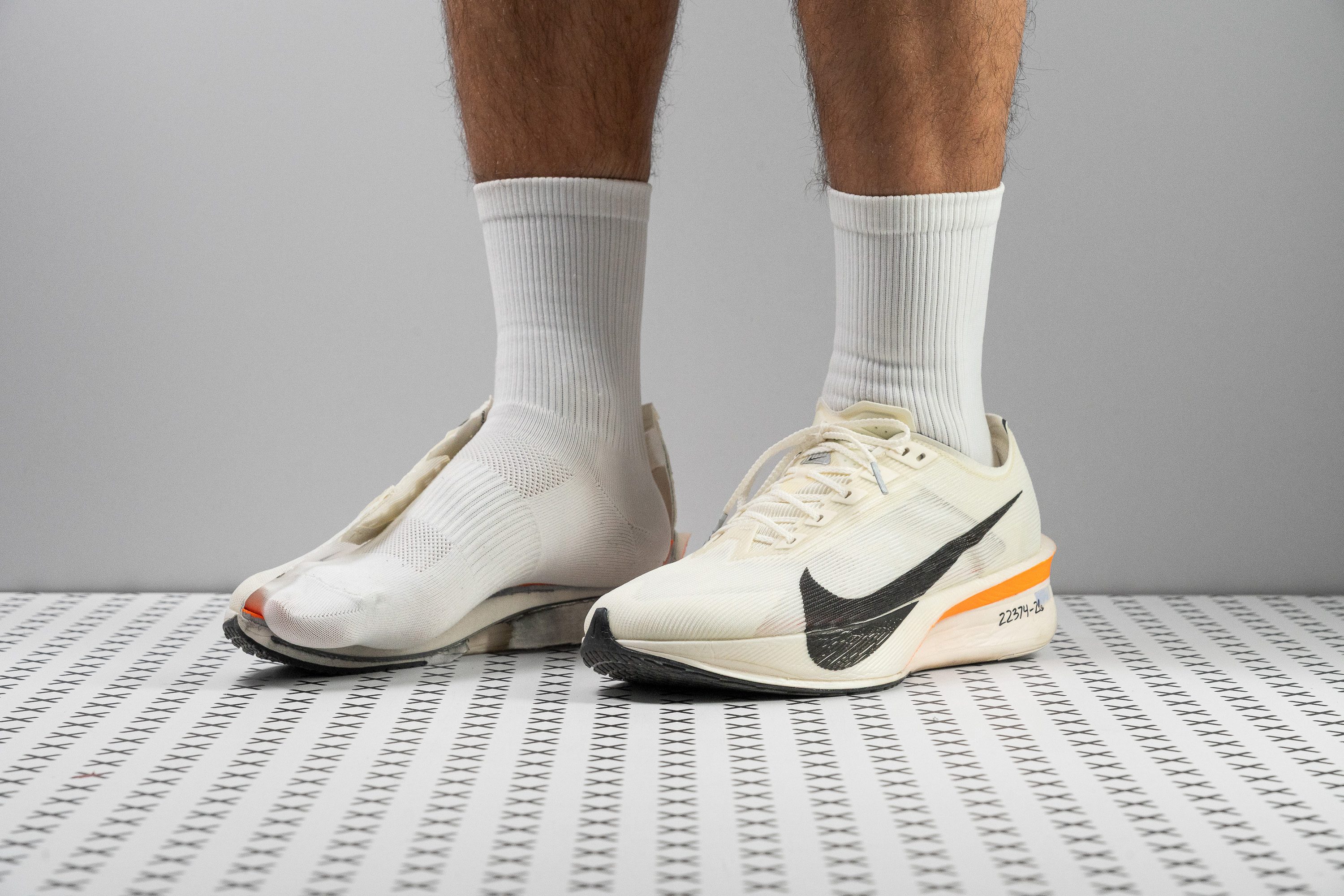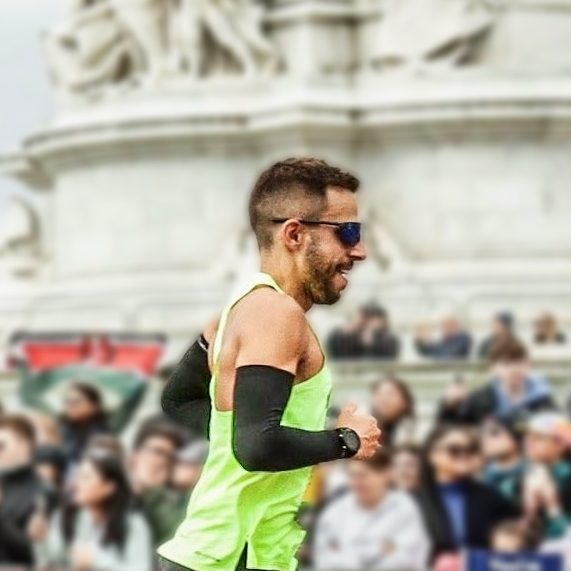Nuestra conclusión
Pros
- Un 13 % más ligeras que las Vaporfly 3
- Ideales para carreras de 5K, 10K y 21K
- Mediasuela ZoomX
- Flyplate de fibra de carbono con rebote
- Muy buen cierre con cordones premium
- Rocker moderado para una pisada más natural
- Plantilla extraíble perforada y mejorada
- Mejor cobertura de caucho en el antepié
- Con mejoras que vienen de las Alphafly 3
- Upper transpirable y duradero
Contras
- Menos adecuadas para maratón
- Todavía carecen de la reactividad de las Vaporfly 1 y 2
- El mediopié y el talón estrechos limitan la estabilidad
Veredicto de los usuarios
- Top 19% entre Zapatillas de running para asfalto
- Top 18% entre zapatillas de running Nike
- Top 6% más vendidas zapatillas de running
Comparativa
Las zapatillas de running más parecidas
+ + Añadir unas zapatillas | |||||
|---|---|---|---|---|---|
| Puntuación global | 90 Excelentes | 81 Buenas | 92 Excelentes | 83 Buenas | |
| Precio | 260 € | 200 € | 250 € | 250 € | |
| Pace | Competición | CompeticiónTempo / series | Competición | CompeticiónTempo / series | |
| Absorción de impactos | Alta | Alta | - | Alta | |
| Retorno de energía | Alto | Alto | - | Moderado | |
| Tracción | Alta | Moderada | - | Alta | |
| Arch support | Neutral | Neutral | Neutral | Neutral | |
| Peso laboratorio Peso marca | 5.9 oz / 166g 6.5 oz / 184g | 7.1 oz / 200g 7.4 oz / 209g | 7.3 oz / 208g 7.4 oz / 210g | 7.5 oz / 213g 7.4 oz / 210g | |
| Lightweight | ✓ | ✓ | ✓ | ✓ | |
| Drop laboratorio Drop marca | 8.6 mm 6.0 mm | 7.5 mm 8.0 mm | 8.1 mm 8.0 mm | 5.1 mm 9.0 mm | |
| Técnica de carrera | TalónMedio/antepié | Medio/antepié | TalónMedio/antepié | Medio/antepié | |
| Talla | Tallan bien | Media talla más pequeñas | Tallan bien | - | |
| Rigidez de la mediasuela | Blanda | Blanda | Firme | Blanda | |
| Diferencia de la rigidez de la mediasuela en frío | Pequeña | Normal | Pequeña | Pequeña | |
| Durabilidad de la parte delantera | Buena | Decente | - | Mala | |
| Durabilidad del acolchado del talón | Media | Media | - | Alta | |
| Durabilidad de la suela exterior | Mala | Buena | - | Buena | |
| Transpirabilidad | Media | Alta | Alta | Media | |
| Anchura / ajuste | Estrecha | Media | Estrecha | Media | |
| Anchura de la parte delantera | Media | Media | - | Media | |
| Flexibilidad | Rígida | Rígida | Rígida | Moderada | |
| Rigidez torsional | Rígidas | Rígidas | Rígidas | Rígidas | |
| Rigidez del contrafuerte del talón | Flexible | Flexible | Flexible | Flexible | |
| Placa | Placa de carbono | Placa de carbono | Placa de carbono | Placa de carbono | |
| Rocker | ✗ | ✗ | ✓ | ✗ | |
| Talón laboratorio Talón marca | 34.1 mm 35.0 mm | 32.9 mm 35.0 mm | 33.3 mm 39.0 mm | 31.5 mm 37.0 mm | |
| Antepié laboratorio Antepié marca | 25.5 mm 29.0 mm | 25.4 mm 27.0 mm | 25.2 mm 31.0 mm | 26.4 mm 28.0 mm | |
| Anchuras disponibles | Estándar | Estándar | EstándarAncho | Estándar | |
| Orthotic friendly | ✓ | ✓ | ✗ | ✓ | |
| Estación | Todas las estaciones | VeranoTodas las estaciones | VeranoTodas las estaciones | Todas las estaciones | |
| Removable insole | ✓ | ✓ | ✗ | ✓ | |
| Clasificación | #64 Top 18% | #294 21% inferior | #20 Top 6% | #252 32% inferior | |
| Popularidad | #21 Top 6% | #169 Top 46% | #192 48% inferior | #363 2% inferior |
Quién debería comprárselas
Después de hacerles montones de pruebas a las Nike Vaporfly 4 en el laboratorio, creemos que:
- Los que se sintieron un poco decepcionados por las Vaporfly 3 estarán contentos con esta actualización, ya que se siente más rápida gracias a su ligereza y a la nueva geometría inspirada en las Alphafly.
- Los corredores ligeros descubrirán que estas zapatillas son una herramienta preparada para la competición que se puede enfrentar tanto a los kilómetros rápidos por asfalto como a maratones completos, y todo ello con un rocker moderado que se siente natural en los pies.
- Para los corredores de tamaño medio son una opción sólida sea cual sea la distancia, con el límite en los 21K. Ofrecen una pisada ágil que destaca a ritmos más rápidos.
- Son las superzapatillas perfectas para los corredores que sienten que los modelos actuales son demasiado altos, chunky o voluminosos. Este es más estable, pero sigue ofreciendo un rendimiento explosivo.
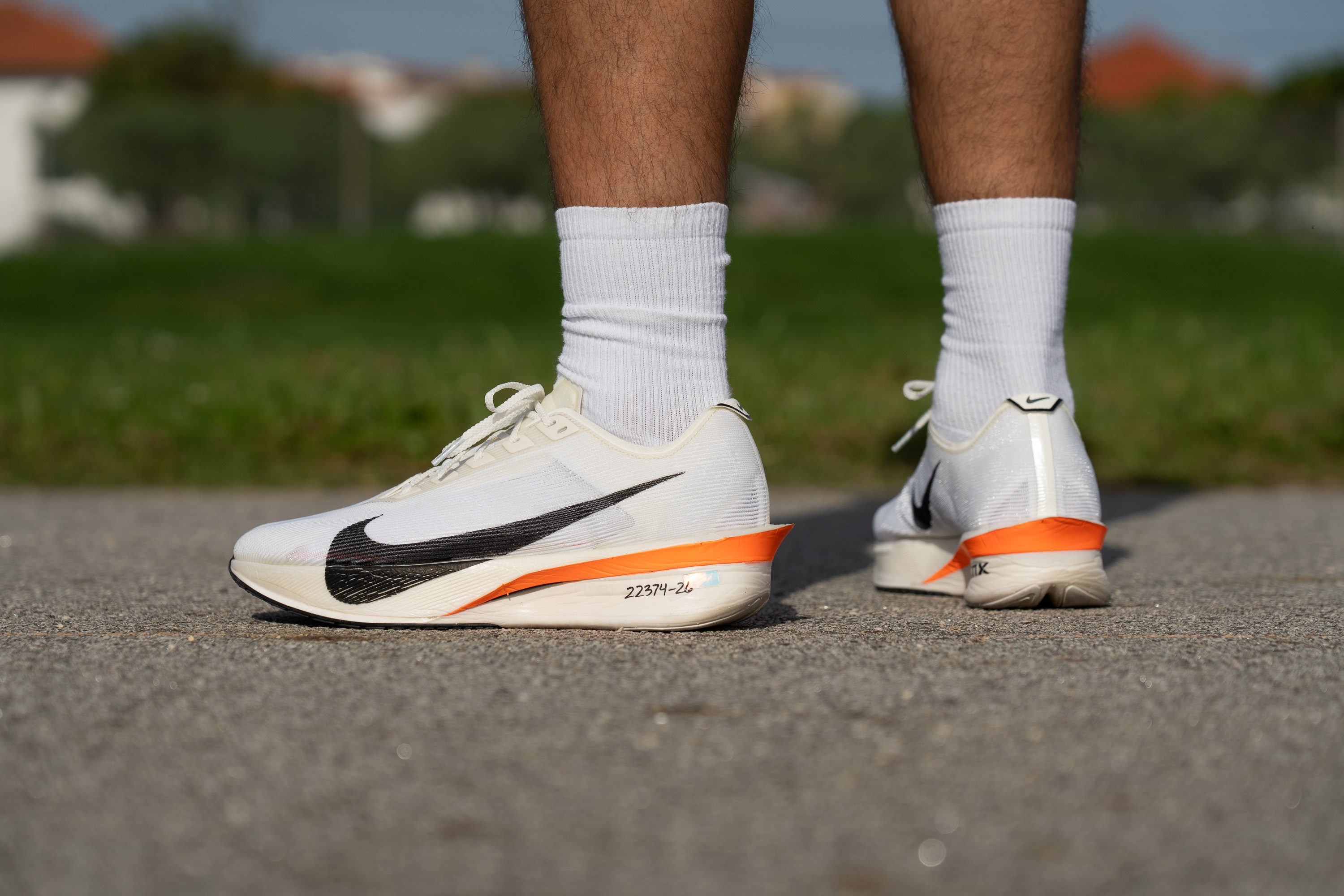
Quién NO debería comprárselas
Creemos que los corredores que no son ligeros a lo mejor terminan un poco decepcionados con las Vaporfly 4 en cuanto a amortiguación, sobre todo si las comparamos con las superzapatillas de última generación. En nuestras pruebas, vimos que su suela no es demasiado alta, así que a los corredores más pesados igual les falta ese extra. Hay otras opciones, como las Nike Alphafly 3 o las ASICS Metaspeed Sky Paris que son más interesantes.
Además, está claro que las Vaporfly 4 siguen siendo caras. Desde nuestro punto de vista, si estás buscando unas buenas zapatillas pero no te quieres gastar un ojo de la cara, deberías echarle un ojo a las Saucony Endorphin Pro 4, que son una opción más razonable; o a las Nike Streakfly 2 si solo corres pruebas de 5K y 10K.
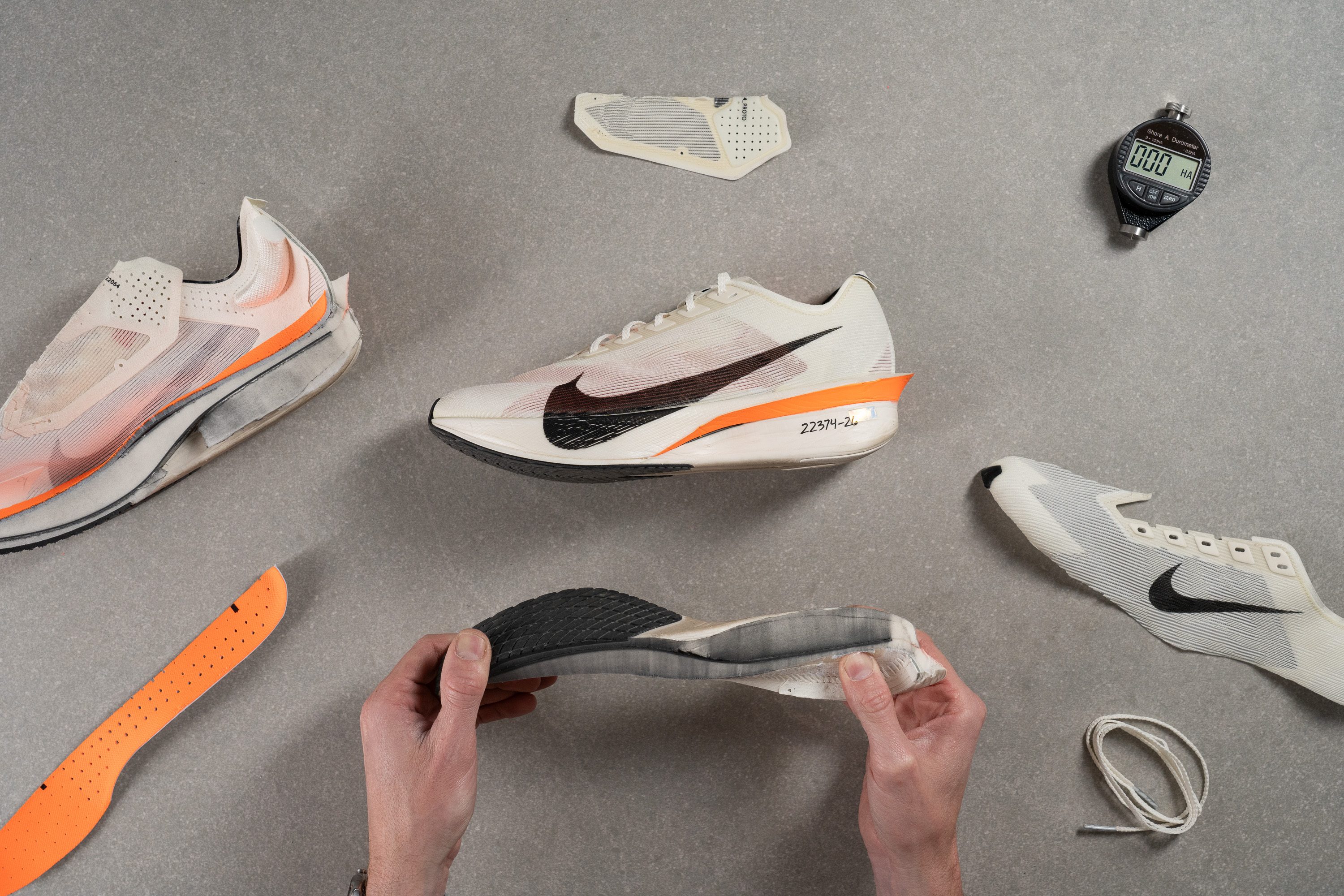
Amortiguación
Shock absorption
Cuando analizamos las Vaporfly 4, se llevaron un resultado maravilloso de 137 SA en el talón, confirmando lo amortiguadísimas que están. Esto hace que estén entre las zapatillas de competición más cómodas para los talonadores y las distancias largas.
Sin embargo, las cosas cambian rápidamente en el antepié, ya que el resultado fue de solo 94 SA. Esto se parece más a una sensación natural en los pies cuando compites, donde se agradece un leve contacto con el suelo y lo último que quieres es hundirte en la media suela.
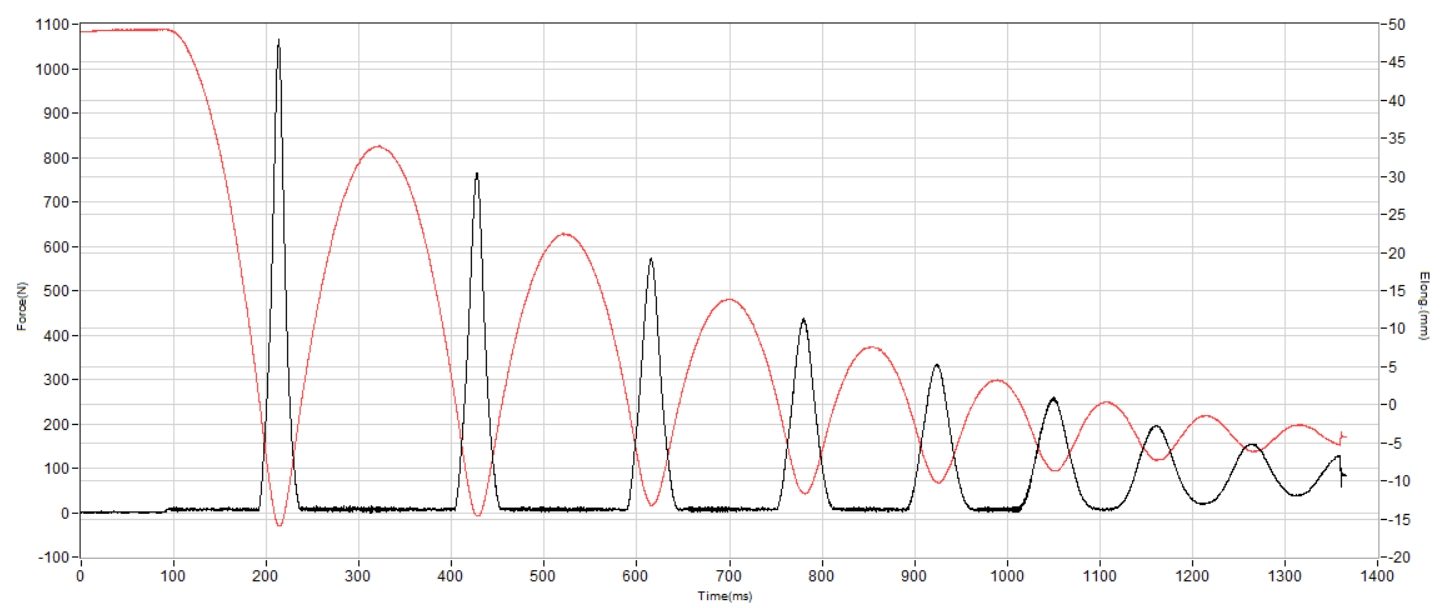
| Vaporfly 4 | 137 SA |
| Media | 129 SA |
Energy return
Cada vez que una marca actualiza unas superzapatillas, lo que todo el mundo se espera es un mejor retorno de energía, y Nike cumplió. Las Vaporfly 4 han alcanzando un impresionante 78,1 %, que es uno de resultados más altos que hemos visto hasta a la fecha. A este ritmo, no nos sorprendería si Nike rompe la barrera del 80 % con la próxima versión.
| Vaporfly 4 | 78.1% |
| Media | 58.5% |
Altura de la suela en la zona del talón
Para nosotros, uno de los principales inconvenientes de las Vaporfly 3 era que perdían su ventaja para las carreras de corta distancia, inclinándose más hacia ser un modelo exclusivo para maratón. Eso cambió con las Vaporfly 4, ya que Nike convirtió estas zapatillas en una opción versátil y con una suela más baja para pruebas de 5K, 10K y media maratón.
Por lo tanto, tampoco hay que preocuparse por el límite de la World Athletics, ya que Nike ha reducido la altura de la suela a 34,1 mm. Es un movimiento raro y atrevido si tenemos en cuenta la tendencia actual, ya que las zapatillas se vuelven cada vez más altas, pero estamos contentos con esta decisión: ahora las Vaporfly 4 encajan perfectamente en la gama de Nike y combinan bien con las Alphafly 3 (si es que te puedes permitir ambos modelos, claro).
Pero, entonces, ¿qué pasa con los maratones? En nuestra experiencia, siguen siendo una buena elección, pero son más adecuadas para los corredores ligeros: es decir, hombres de menos de 65 kg y mujeres de menos de 55 kg. De lo contrario, un modelo que se acercase más a esos 40 mm de altura de la suela sería, probablemente, una elección más inteligente.
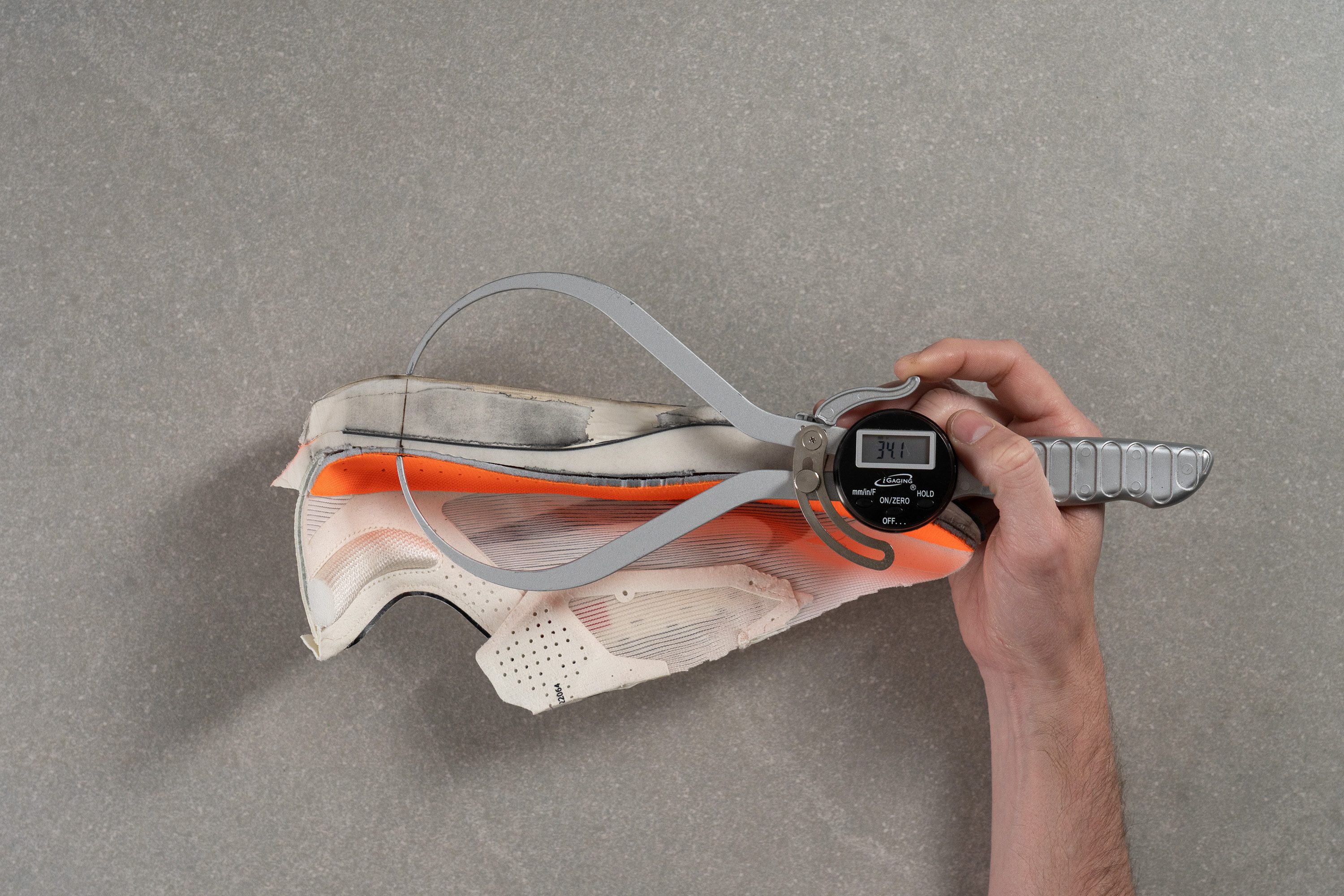
| Vaporfly 4 | 34.1 mm |
| Media | 34.8 mm |
Altura de la suela en el antepié
Como era de esperar, también se ha reducido la altura de la suela en el antepié, que ahora mide 25,5 mm. Sin embargo, no se trata de un cambio importante, ya que medimos las Vaporfly 3 en el laboratorio y nos dio 26,0 mm.

Los corredores de metatarsos disfrutarán de una sensación conocida bajo los pies, aunque hemos visto que hay menos espuma en el mediopié. En nuestra opinión, los que estén buscando algo un poco más mullido en el antepié deberían echarle un ojo a las Adidas Adizero Adios Pro 4, aunque también son más voluminosas.
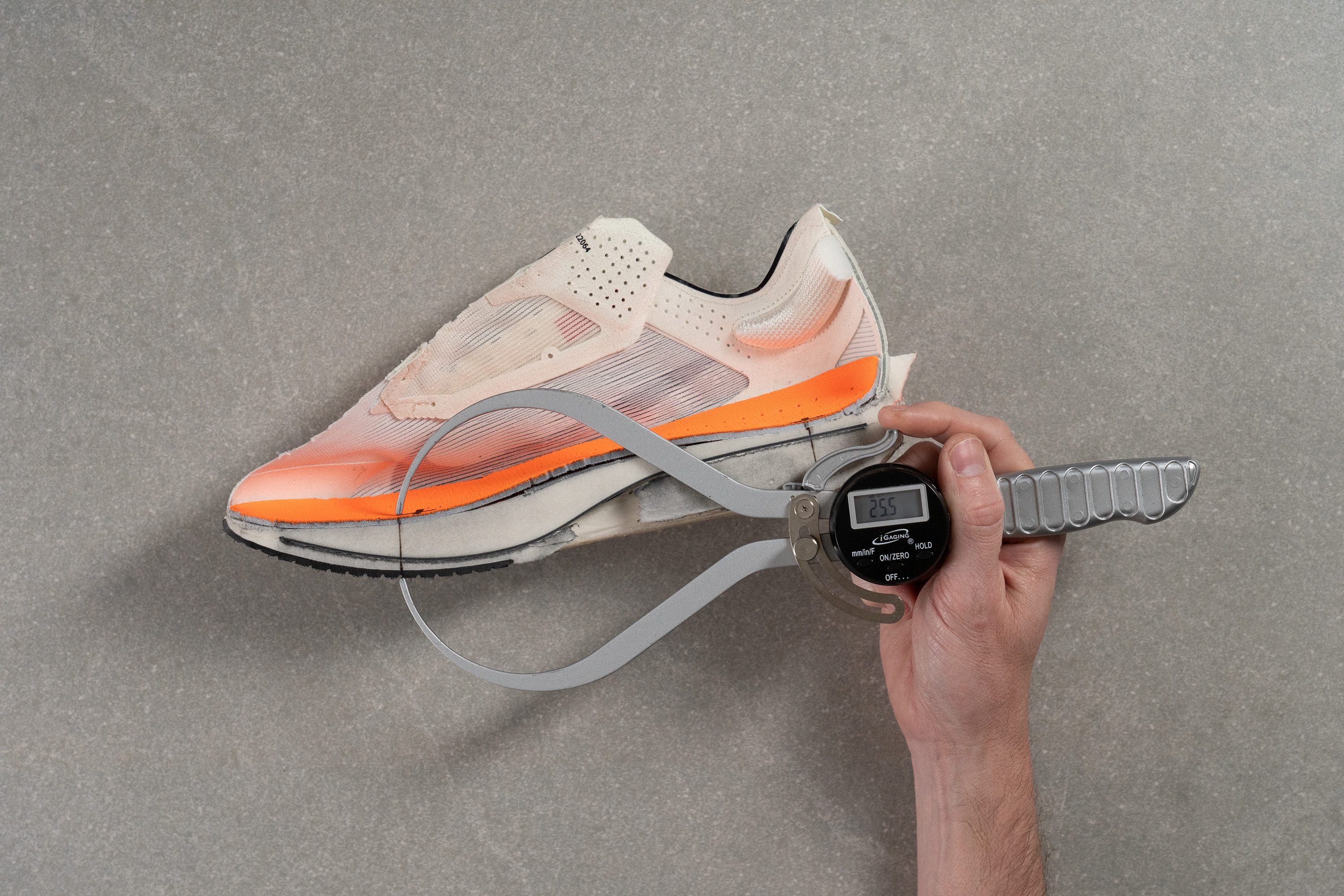
| Vaporfly 4 | 25.5 mm |
| Media | 26.2 mm |
Drop
Otro gran cambio en este modelo es que Nike dice que su drop es de ahora solo 6 mm. Para ayudarnos a saberlo, la marca puso dos puntitos justo donde se mide la altura de la suela según las normas de la World Athletics, ¡que es algo que nos ha encantado!
El problema es que, después de analizarlo y medirlo cuidadosamente varias veces, a nosotros el drop nos dio 8,6 mm. Incluso así, la pisada se siente mucho más plana en comparación con las Vaporfly 3, que cuando lo medimos nos dio 11,1 mm. Parece que Nike dice que los drops son más bajos de lo que afirman nuestras pruebas de laboratorio.
Eso sí, este nuevo drop sigue siendo muy bueno para unas superzapatillas, así que creemos que serán cómodas sea cual sea tu técnica de carrera.
| Vaporfly 4 | 8.6 mm |
| Media | 8.6 mm |
Suavidad de la mediasuela
No hay grandes cambios en cuanto a la espuma, ya que Nike sigue con la ZoomX. Aunque hay marcas como PUMA que están haciendo grandes avances con nuevos compuestos como el A-TPU, nuestro microscopio nos enseñó que este modelo no trae nada nuevo: es la misma Pebax de versiones anteriores.

Nike eligió un enfoque equilibrado y estas zapatillas se sienten un poquito más firmes que las VF3. No son blandas como una nube, que es algo que nos parece acertado, ya que los corredores más poderosos podrían terminar chafando el compuesto al haber reducido la altura de la suela en el antepié. Nuestro durómetro marcó 19,9 HA, así que la sensación bajo los pies es buena, evitando que sientas que la espuma se hunde.
El retorno de energía es magnífico, como esperábamos. Sin embargo, todos sabemos que Nike ya no es la líder: ahora las Vaporfly están a la altura de la mayoría de las superzapatillas. Si esperabas un milagro en cuanto a rebote... el de este modelo es exactamente igual que el de las Vaporfly anteriores.
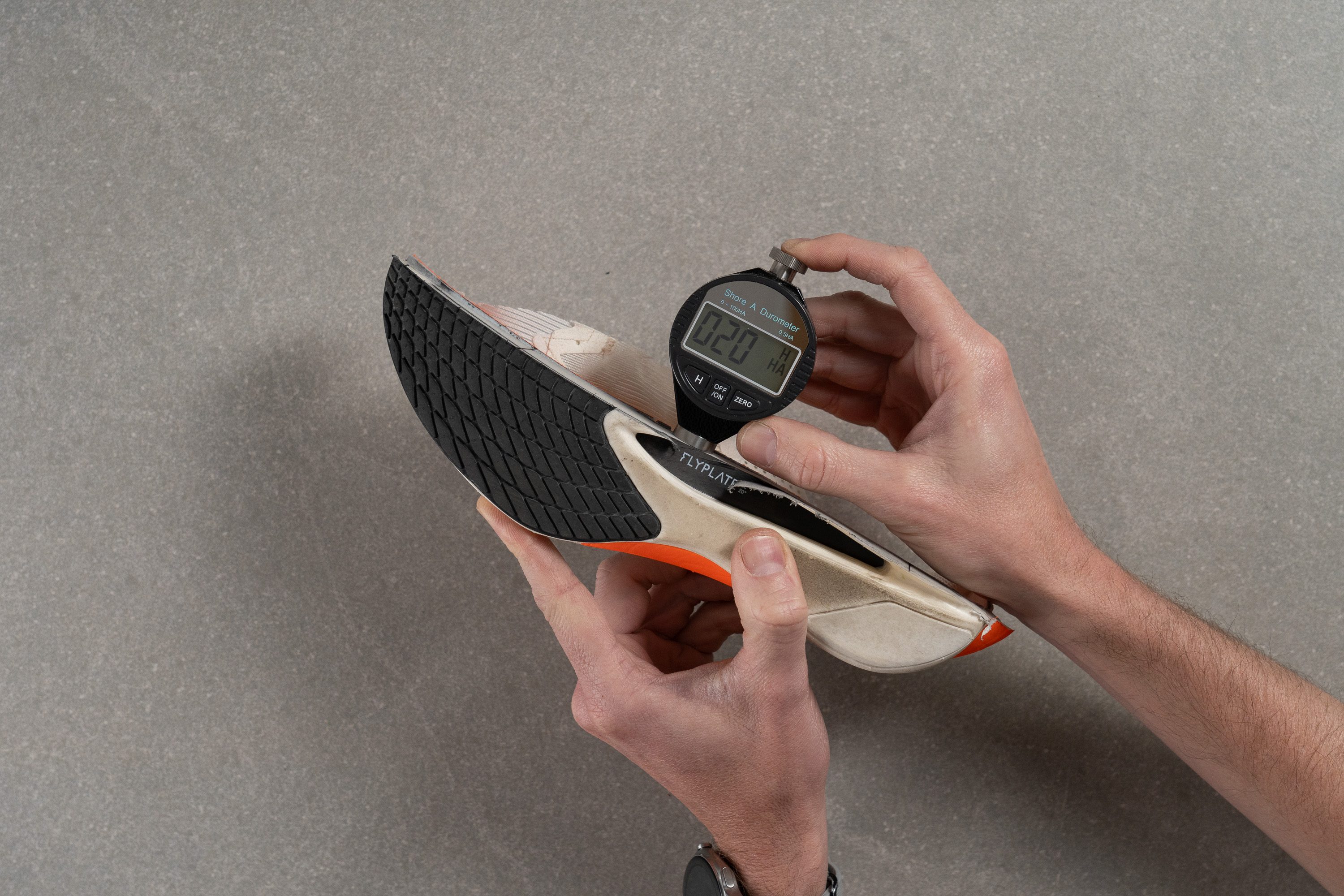
| Vaporfly 4 | 19.9 HA |
| Media | 20.4 HA |
Suavidad de la espuma secundaria
Nike inventó la receta de las superzapatillas: dos capas de espuma con una placa de carbono intercalada. En las Vaporfly 4, descubrimos que ambas placas ZoomX tienen una suavidad casi idéntica, con la secundaria alcanzando los 20,0 HA.
Este diseño no es muy común, ya que la mayoría de las marcas optan por una configuración de doble densidad. Sin embargo, en estas zapatillas, funciona a la perfección, proporcionando una sensación de suavidad y consistencia en la planta del pie que resulta muy agradable en las carreras a ritmo rápido.

| Vaporfly 4 | 20.0 HA |
| Media | 22.7 HA |
Rocker
Nike no deja de nadar a contracorriente con las Vaporfly 4. Ha hecho que su suela sea más bajita (algo casi inaudito en la actualización de unas superzapatillas) y ha puesto un rocker muy suave en la punta... que no sabemos si llamarlo rocker, la verdad. La curvatura del talón, heredada de la AF3, también es casi inexistente.
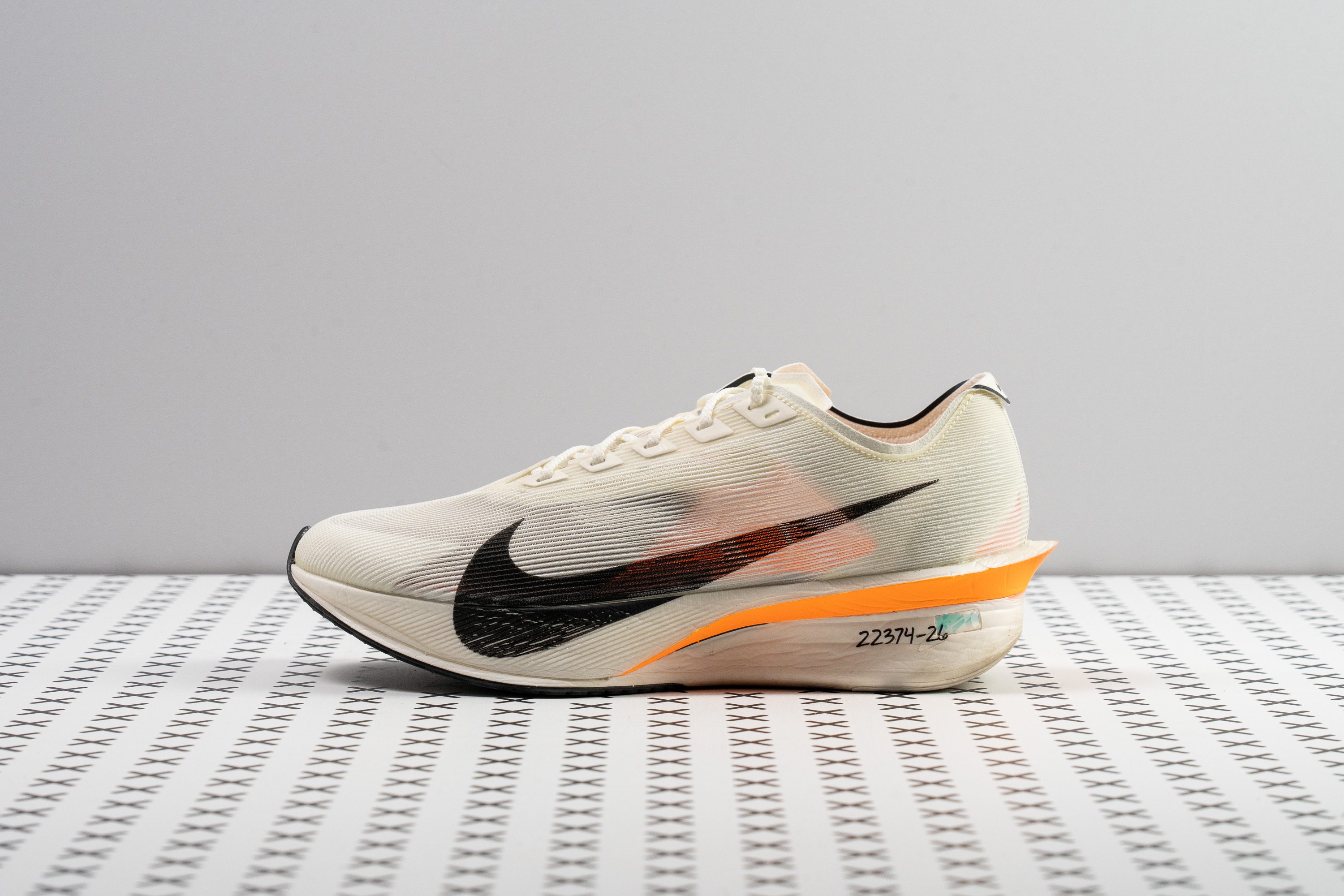
Mientras que la mayoría de las zapatillas de la competencia tienen un rocker mucho más pronunciado, y algunas incluso alcanzan el nivel de las HOKA Cielo X1, Nike está diseñando una opción que les guste a los corredores que quieren una pisada menos asistida, fomentando así los aterrizajes con el primer metatarsiano, donde la placa se dobla y hace palanca.
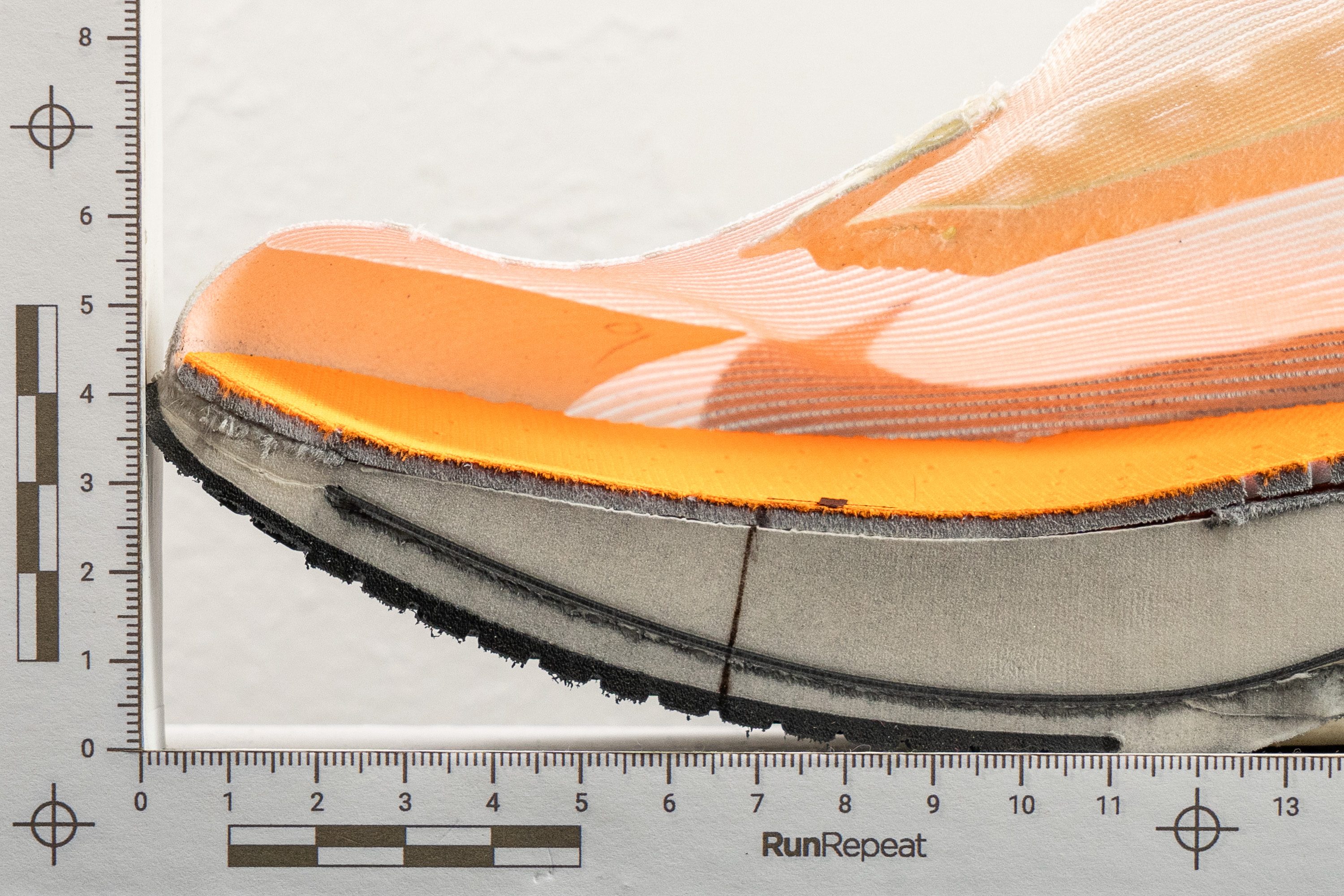
Placa
La placa Flyplate de fibra de carbono que va del talón a la punta sí que ha cambiado un poco. Ahora está más cerca del talón y se curva un poco más por el mediopié y por el antepié, haciendo que la icónica forma de cuchara sea incluso más espectacular.
Después de hacerle montones de pruebas, descubrimos que esta nueva Flyplate mejora el rebote y hace que los despegues sean un poco más rápidos y ágiles, aunque bajo los pies la pisada sigue siendo muy conocida para los fans de las Vaporfly.

Tallaje y ajuste
Talla
Las Nike Vaporfly 4 tallan bien (137 votos).
Anchura / Ajuste
Una de las preocupaciones habituales de cualquiera que quiera actualizar sus Vaporfly es el ajuste. ¿Es parecido al de la versión anterior? Pues mira, en RunRepeat nos enfrentamos a estas preguntas sin que nos tiemble el pulso gracias a nuestra prueba de gel, que es muy precisa y nos disipa todas las dudas.
Cuando medimos la parte más ancha de estas zapatillas, nos dio 91,7 mm, por lo que su ajuste es un poco más ceñido que los 94,3 mm que vimos en la versión anterior. En nuestra opinión, que ahora midan 1,3 mm menos a cada lado no debería ser un problema para la mayoría de los corredores, pero los que sintieron que ya las VF3 les quedaban demasiado justan a lo mejor podrían echarle un ojo a las New Balance FuelCell SuperComp Elite v4.

| Vaporfly 4 | 91.7 mm |
| Media | 95.1 mm |
Anchura de la parte delantera
La zona del dedo gordo se mantiene prácticamente igual que la de sus predecesoras, ofreciendo unos generosos 73,2 mm para ser unas superzapatillas. Este ajuste espacioso es una ventaja para las pruebas de larga distancia y para los corredores a los que no les gustan las partes delanteras demasiado apretadas.

| Vaporfly 4 | 73.2 mm |
| Media | 73.2 mm |
Altura de la parte delantera
Creemos que las Vaporfly 4 no deberían ni hacerte rozaduras ni dejarte las uñas negras si su longitud es la adecuada.
Miden 27,3 mm (como la mayoría de las zapatillas de entrenamiento diario), así que la sensación es relajada y libre de presiones incluso en las carreras largas.
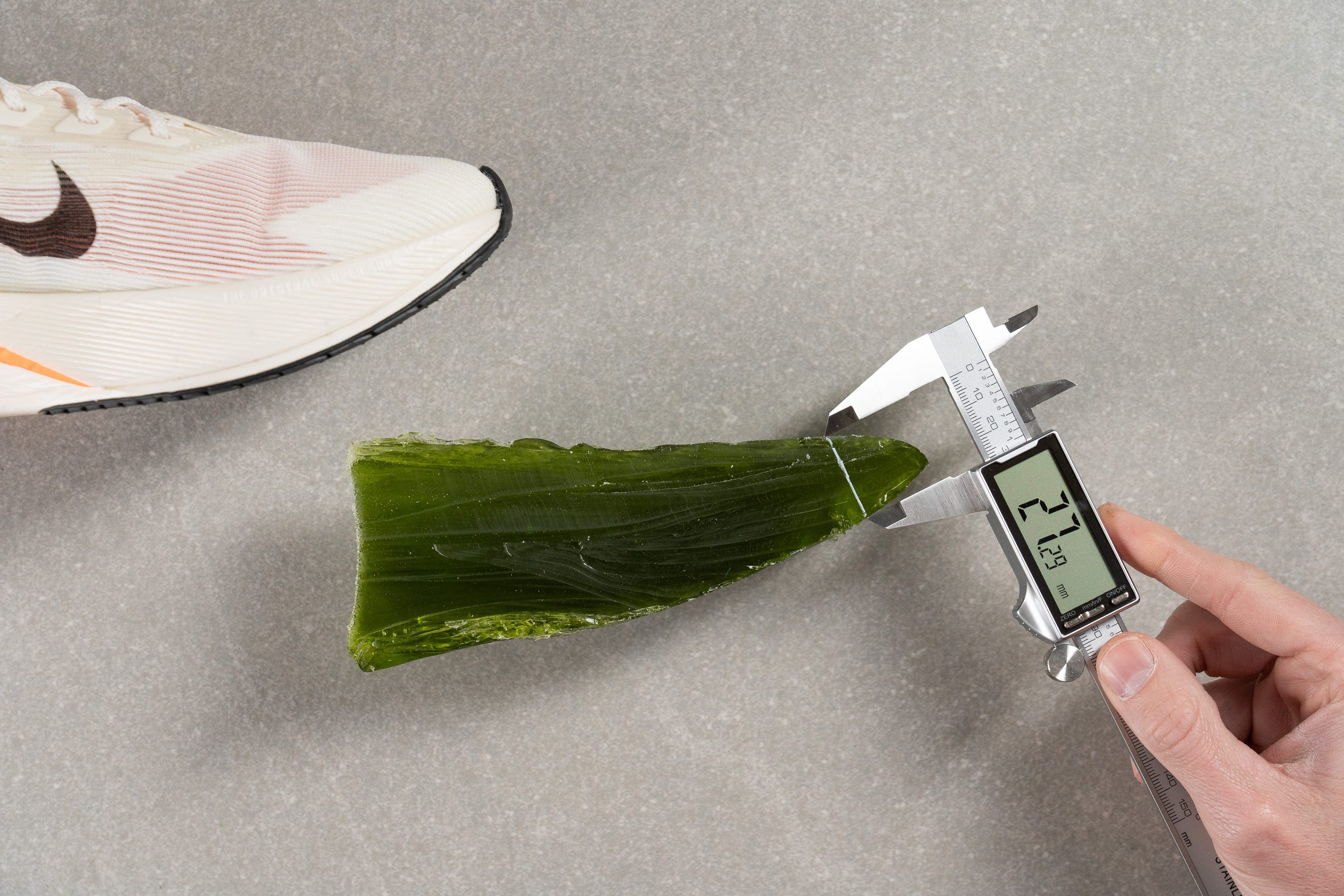
| Vaporfly 4 | 27.3 mm |
| Media | 27.1 mm |
Tracción / Agarre
Traction test
Evaluamos la tracción de las Vaporfly 4 en nuestra máquina SATRA TM144 personalizada para poder compararla con la de otras superzapatillas. Se llevaron un 0,45, que es un resultado decente, pero están un poquito por detrás de las Vaporfly 3.
Incluso así, las VF4 se mantuvieron firmes en las carreteras empapadas, ofreciendo un agarre listo para la lluvia que hace que no pierdas la estabilidad incluso cuando la cosa se pone complicada.
| Vaporfly 4 | 0.45 |
| Media | 0.48 |
Diseño de la suela exterior
Con respecto a la suela exterior, hay varias actualizaciones que queremos destacar. Las Vaporfly 4 combinan elementos de las Alphafly 3 y de las Vaporfly Next% 2, sobre todo en el antepié rediseñado. Nike al fin ha eliminado los cortes que tienen las Vaporfly 3, volviendo a una cobertura de caucho más uniforme que nos recuerda a la primera y segunda versión.
Por otro lado, el talón utiliza el mismo diseño y materiales de las Alphafly 3. Es algo que nos parece preocupante para los talonadores, sobre todo si en cuanto a la durabilidad a largo plazo.
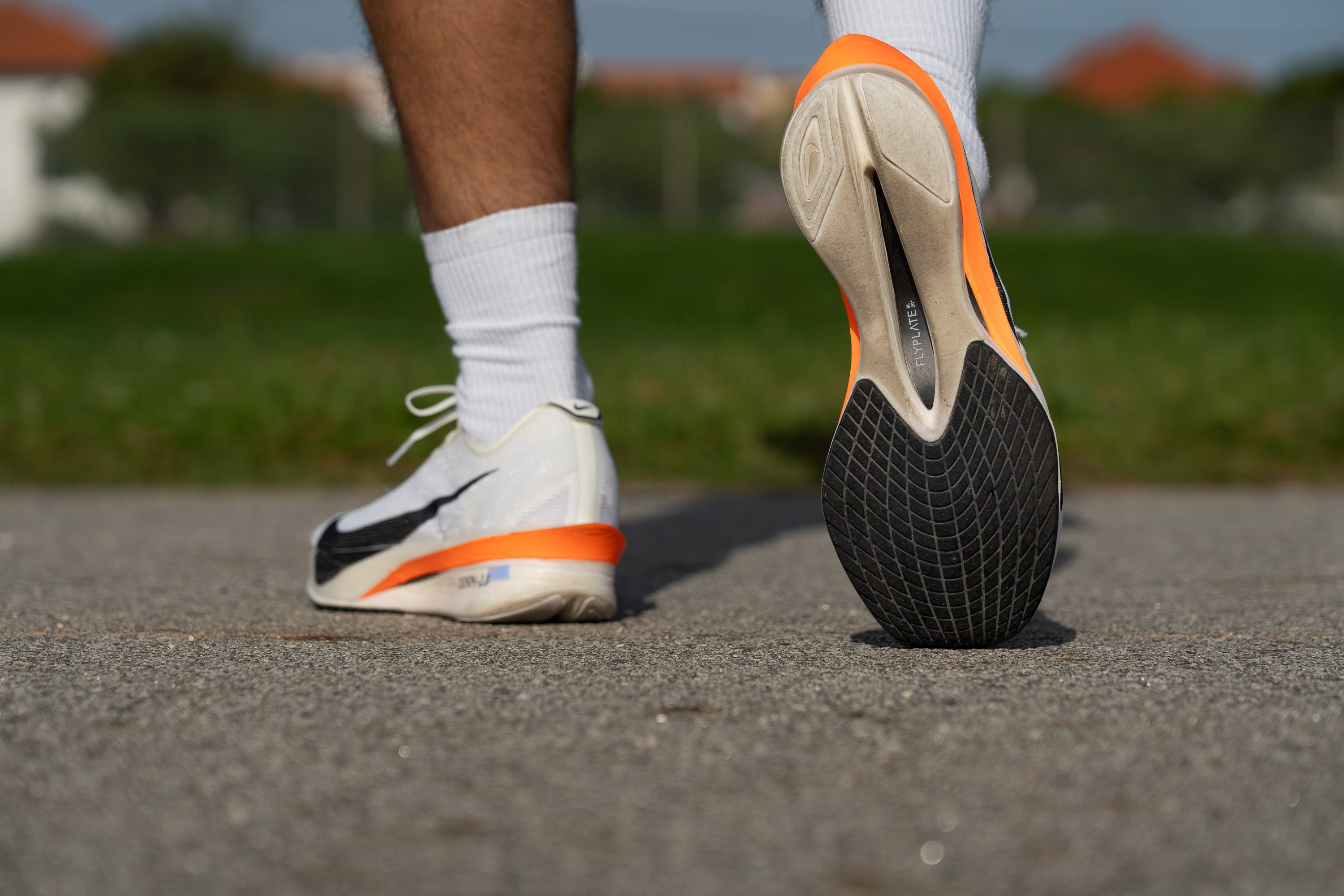
Flexibilidad / Rigidez
El grosor de la Flyplate tampoco cambia mucho, y la forma es casi idéntica a la de la v3. Sin embargo, como la suela de este modelo es un poco más baja, ha perdido una pizquita de rigidez: de 18,4 N a 18,0 N. Sea como fuere, la sensación bajo los pies es prácticamente la misma, así que la pisada se parece mucho a la de otras superzapatillas de velocidad.
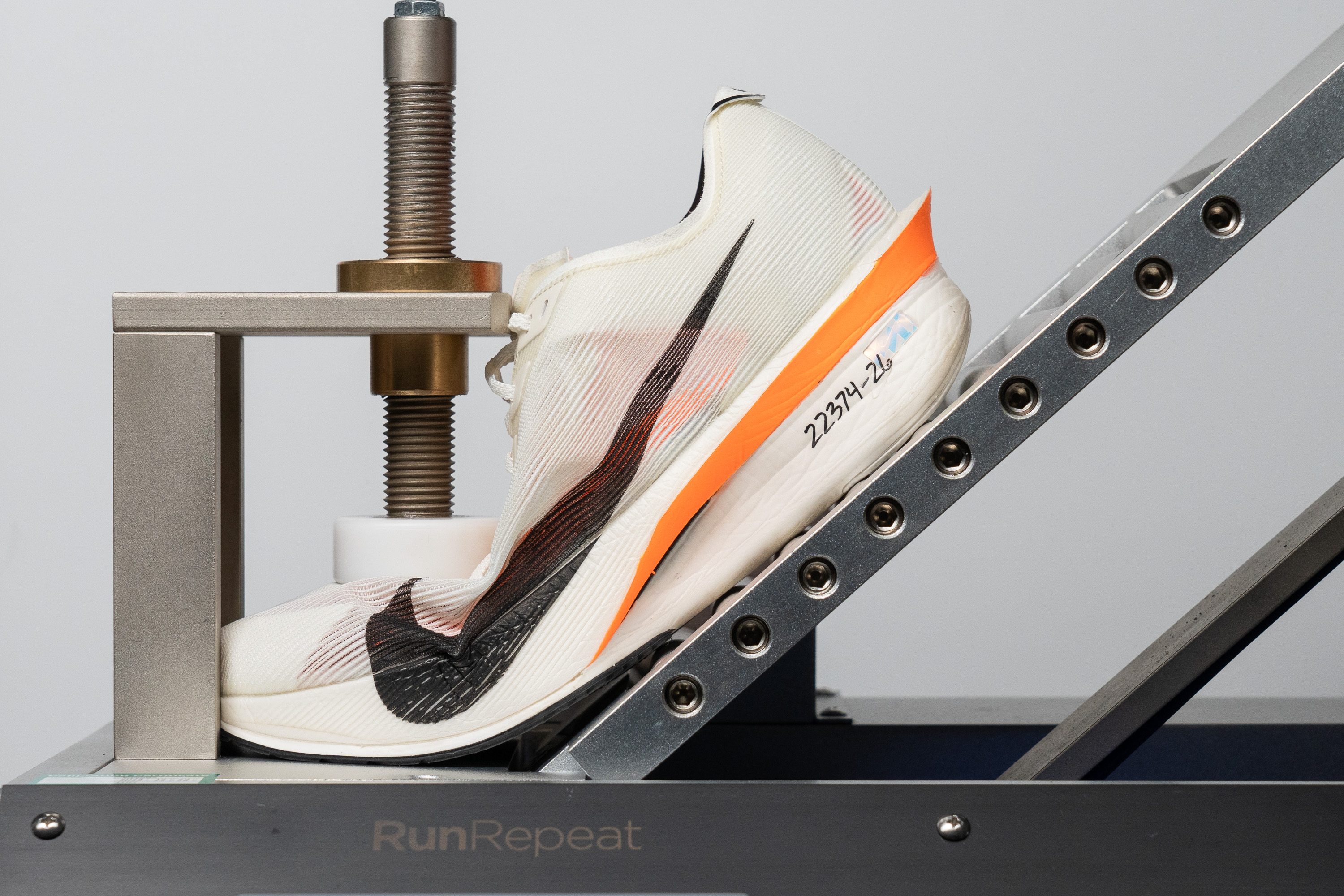
| Vaporfly 4 | 18.0N |
| Media | 15.3N |
Peso
Esta es la mejora más destacada de las Vaporfly, y la razón principal para elegir la versión 4 en lugar de sus predecesoras. Con 166 gramos, estamos ante una reducción de peso del 13 % respecto a las Vaporfly 3, que es algo muy difícil de conseguir a este nivel.

¿Que cómo ha conseguido Nike hacer esto? Pues mira, hemos descubierto 3 factores principales:
- El diseño de la mediasuela: Inspirándose en las Alphafly 3, la marca ha ahuecado el centro de la mediasuela, que es lo que más reduce el peso.
- El upper y la lengüeta: Se han hecho ajustes pequeños pero efectivos para reducir algunos gramos.
- Una suela más baja: Como decíamos antes, Nike ha reducido ligeramente la altura de la suela, lo que contribuye a bajar el peso.
Desde nuestro punto de vista, parece que el nuevo estándar para las superzapatillas girará entorno a los 170-200 g, con ASICS, Adidas y PUMA apuntando ya hacia ese límite o incluso superándolo. ¡Y claramente Nike quiere seguir ese mismo camino!
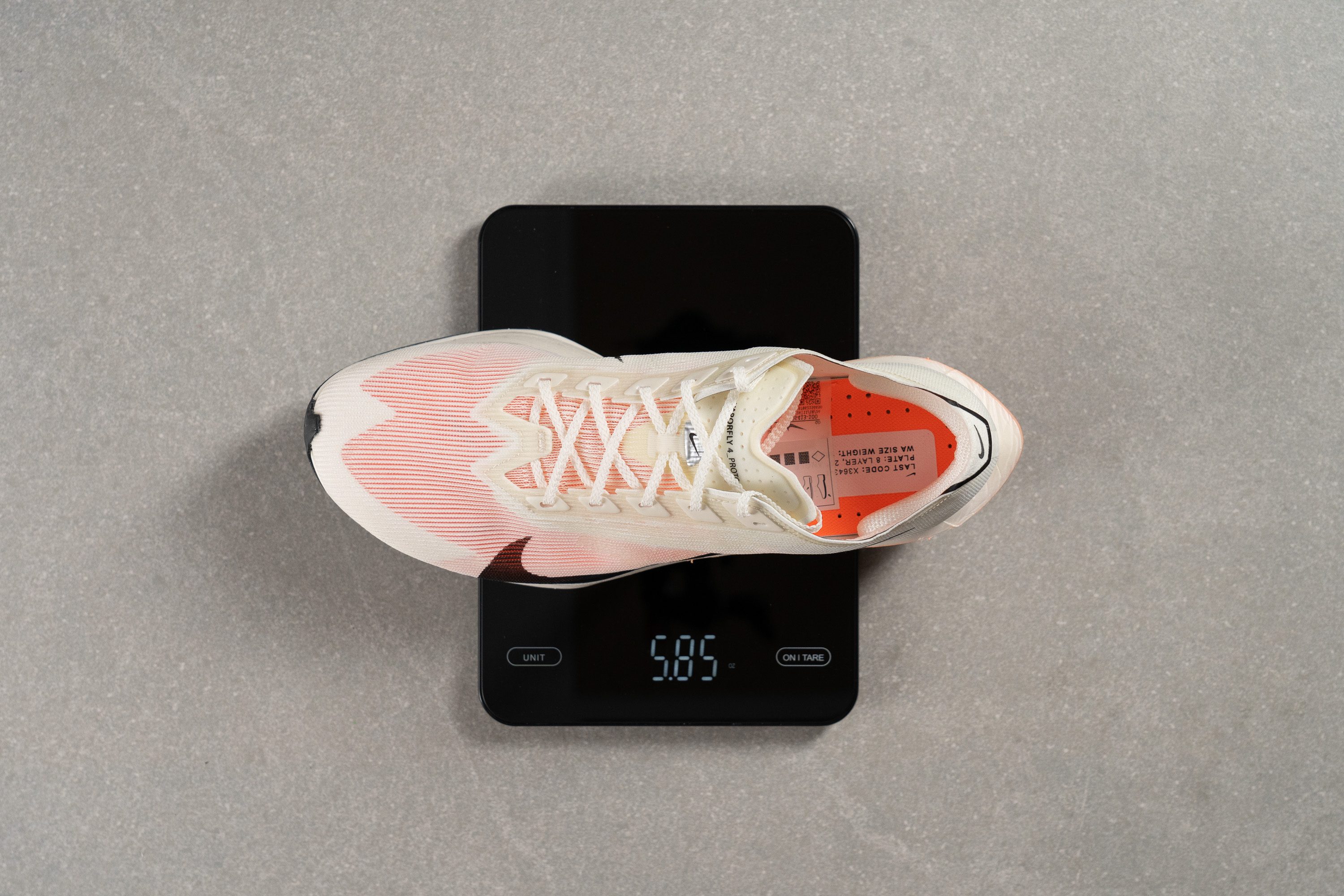
| Vaporfly 4 | 5.9 oz (166g) |
| Media | 9.3 oz (264g) |
Transpirabilidad
Nike adoptó un nuevo enfoque con el upper de las Vaporfly 4. Las Vaporfly 3 tienen unos agujeros gigantes para el flujo de aire, parecidos a los de las Brooks Hyperion Elite 4, pero en esta actualización Nike ha pasado completamente de eso.
Como resultado, la transpirabilidad es un poquito peor que en la versión anterior, pero el rendimiento sigue siendo muy bueno. Teniendo en cuenta que la mayoría de maratones se corren cuando hace fresquito, creemos que el 4/5 que se ha llevado este modelo es justo, y la verdad es que nos ha dejado satisfechos.
Gracias a nuestras pruebas, descubrimos que las Vaporfly 4 ofrecen una transpirabilidad uniforme en la parte delantera y en el mediopié. La verdad es que es un movimiento inteligente, sobre todo para los corredores que tienden a tener mucho calor en la zona del arco.
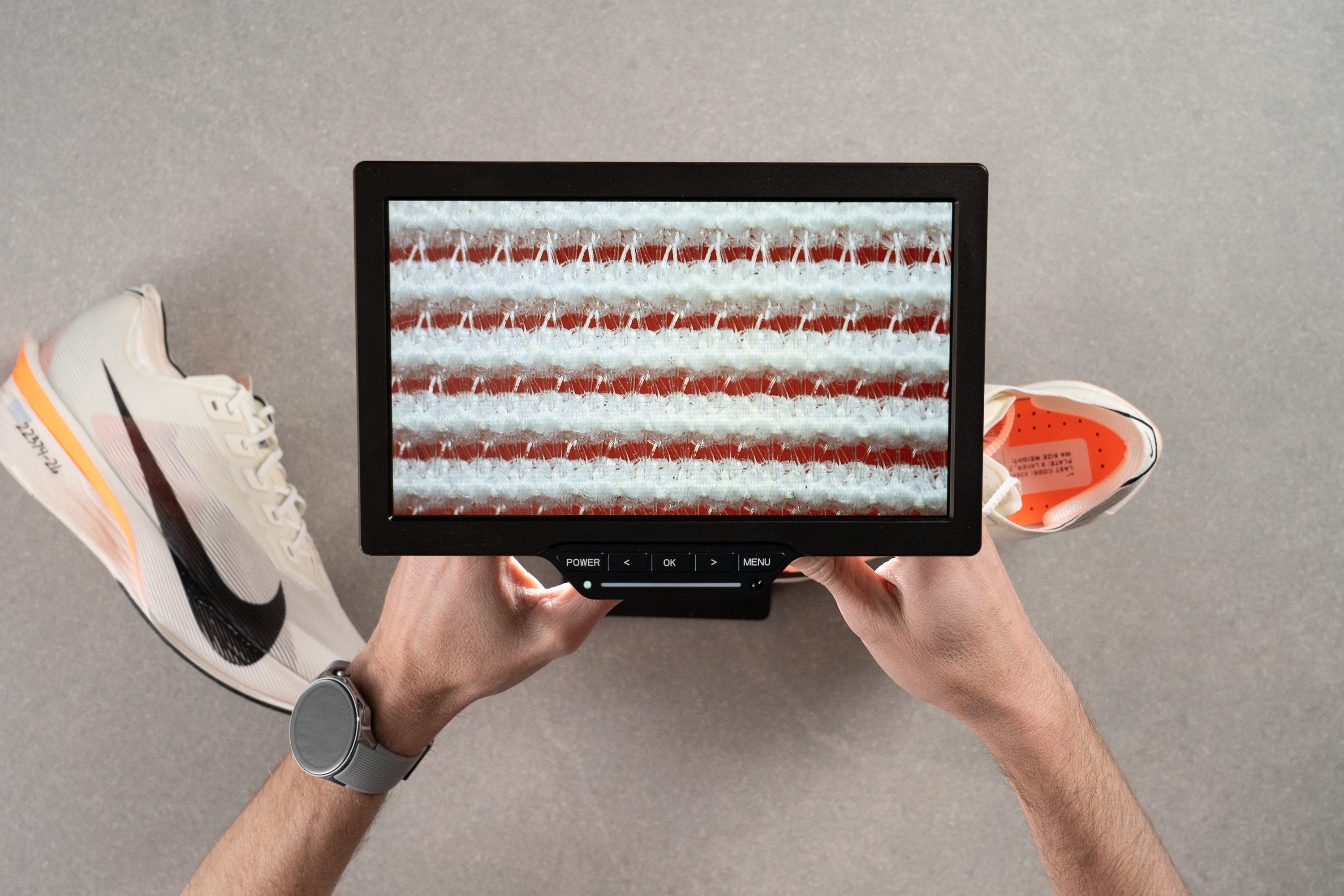
Usando nuestro microscopio, pudimos ver cómo Nike diseñó este upper. Combinó hilos gruesos y resistentes con un material ultrafino, casi transparente, para mantener la estructura y la durabilidad sin añadir peso innecesario.

En nuestra opinión, estamos ante un diseño muy funcional y transpirable que debería ser duradero sin tener que sacrificar el rendimiento.
Aunque no alcanza la comodidad ultra elástica del Atomknit de las Alphafly 3 (Nike ha vuelto a dejar el Flyknit fuera de las Vaporfly), podemos decirte con seguridad que este upper nos da justo lo que necesitamos de unas superzapatillas de primera.
| Vaporfly 4 | 4 |
| Media | 3.7 |
Estabilidad
Prueba de estabilidad lateral
Las Vaporfly nunca han sido unas de las superzapatillas más estables y, en nuestra opinión, esta historia no ha cambiado con la versión 4. No son muy estables, y menos para los talonadores, ya que este modelo sigue siendo muy estrecho en el retropié.
Sin embargo, nos hemos dado cuenta de que a los corredores pueden serles un poco más estables que la versión anterior porque la suela es más bajita, que es algo que sin duda se siente bajo los pies.
Rigidez torsional
Aunque tienen una placa de carbono, las Vaporfly 4 no alcanzan la máxima rigidez torsional, ya que se llevaron un 4/5. Esta es una de esas características de las Vaporfly que... o te gustan, o las odias. A nosotros nos parece que así son más accesibles y cómodas, tratando de satisfacer tanto a los corredores de élite como a los que salen a enfrentarse a sus marcas solo los fines de semana.
Pero creemos que esta decisión también tiene su lado malo, ya que los corredores más rápidos prefieren las estructuras más rígidas que ofrecen una pisada agresiva y llena de energía en los esfuerzos más rápidos, como la primera y la segunda generación de la serie Vaporfly.
| Vaporfly 4 | 4 |
| Media | 3.5 |
Rigidez del contrafuerte del talón
El contrafuerte del talón deja que tus tendones y músculos se encarguen de la mayor parte de la estabilidad, aunque sigue ofreciendo un poco de sujeción y estructura. Por eso se llevó un 2/5 en nuestra prueba de laboratorio.
| Vaporfly 4 | 2 |
| Media | 2.9 |
Anchura de la mediasuela - antepié
Una de las características que ha definido la serie Vaporfly a lo largo de los años ha sido su tamaño compacto, manteniéndose alejada de los diseños voluminosos. Eso es algo que nos encanta, ya que sus modelos siempre se han sentido ágiles y reactivos bajo los pies.
Descubrimos que Nike hizo que las Vaporfly 4 fuesen un poco más espaciosas que las VF3, sumándoles 3 mm para alcanzar los 110,6 mm. Incluso así, siguen estando muy por debajo de la media de las zapatillas de running.
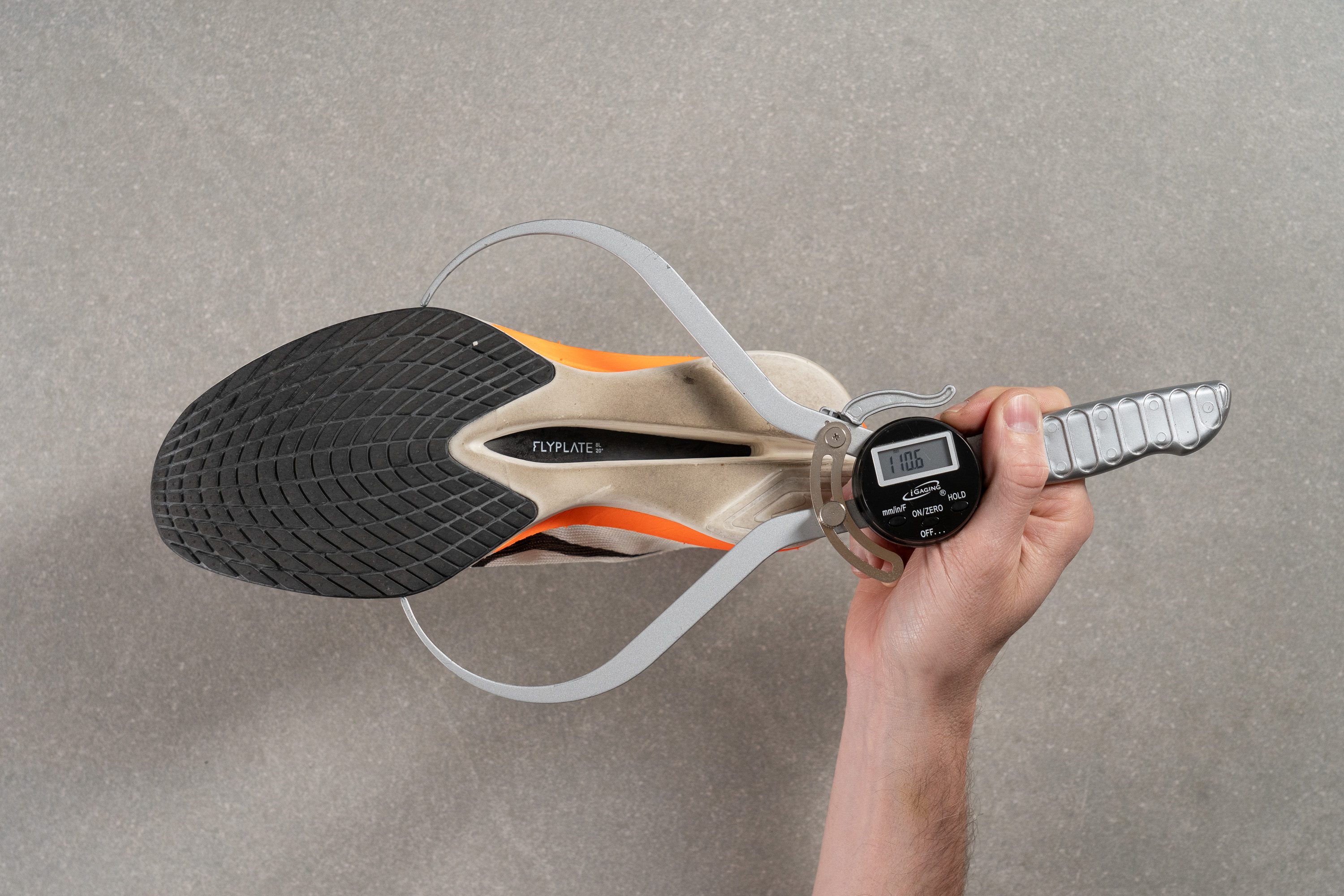
| Vaporfly 4 | 110.6 mm |
| Media | 114.4 mm |
Anchura de la mediasuela - talón
Con solo 77,0 mm, el talón no tiene mucha plataforma sobre la que aterrizar, haciendo que estas zapatillas nos recuerden a las Nike Dragonfly 2 Elite, que son muy agresivas. Una vez más, se mantienen fieles a sus raíces, ya que no pierden el ADN competitivo de las Vaporfly.
Para darte un poco de contexto, el talón de la Alphafly 3 mide nada más y nada menos que 91,9 mm, que es una pasada para unas superzapatillas.

| Vaporfly 4 | 77.0 mm |
| Media | 90.7 mm |
Durabilidad
Durabilidad de la parte delantera
Este cambio de diseño valió la pena, ya que pasamos de un decepcionante 1/5 a un impresionante (para unas superzapatillas) 4/5 en la durabilidad de la parte delantera. Además, todo esto se consigue sin sacrificar la transpirabilidad, por lo que estamos ante una mejora fantástica.
| Vaporfly 4 | 4 |
| Media | 2.6 |
Durabilidad del acolchado del talón
Las Vaporfly nos ofrecieron un resultado sólido en cuanto a la durabilidad del acolchado del talón, y más teniendo en cuenta que está totalmente expuesto. Por lo tanto, un 3/5 nos parece un resultado bastante bueno incluso siendo más bien estándar.
| Vaporfly 4 | 3 |
| Media | 3.4 |
Durabilidad de la suela
Empezamos dándole caña al antepié, donde los daños fueron de 4,6 mm. No podemos decir que sea un buen resultado, y si tiendes a desgastar mucho la suela exterior, entendemos que esto te preocupe.
Después, nos centramos en la zona del talón. Basándonos en nuestra experiencia, ya sabíamos que este material tan blandito no estaba hecho para ser duradero a largo plazo, y una vez más el Dremel lo desgarró con facilidad, alcanzando una preocupante profundidad de 8,6 mm.
Ahora que tenemos todos estos datos, tenemos algo que decir. Esta prueba puede ser un poquito demasiado agresiva para este material en concreto, ya que nosotros la diseñamos para el caucho estándar que tienen el 99 % de las zapatillas. Por lo tanto, aunque en el día a día esto siga siendo un punto débil de este modelo, no llega a ser tan terrible, sobre todo teniendo en cuenta nuestra experiencia después de todos los kilómetros que nos hicimos en las Alphafly 3.
| Vaporfly 4 | 8.6 mm |
| Media | 1.1 mm |
Grosor de la suela
El grosor del caucho en el talón es de 2,3 mm, así que es más bien finito. Eso es justo lo que nos esperábamos de unas superzapatillas de alto rendimiento.

| Vaporfly 4 | 2.3 mm |
| Media | 3.2 mm |
Varios
Grosor de la plantilla
La plantilla es bastante fina, de 2,9 mm, con el objetivo de maximizar la experiencia ZoomX tanto como sea posible. Sin embargo, nos preguntamos si Nike fabricará algún día una plantilla ZoomX..., ¡porque sería una pasada!
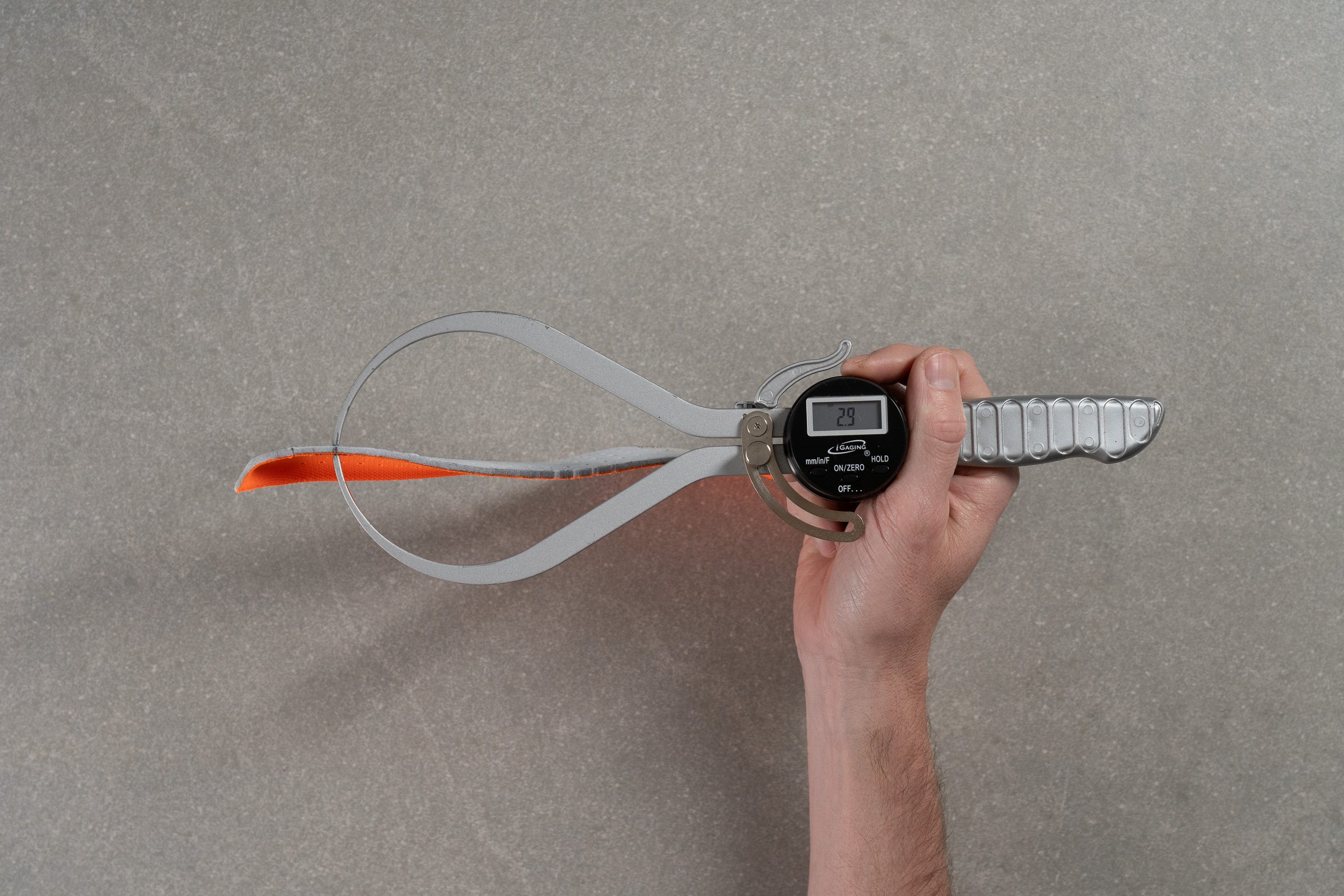
| Vaporfly 4 | 2.9 mm |
| Media | 4.5 mm |
Plantilla extraíble
Una buena mejora de las Vaporfly 4 es que ahora su plantilla es extraíble (no como en las Vaporfly 3) y tiene perforaciones que reducen el peso y mejoran el flujo de aire. La verdad es que nos encantó este detalle, que viene de la mano de su precio premium.
| Vaporfly 4 | Sí |
Rigidez de la mediasuela en frío (%)
La ZoomX está fabricada con Pebax, lo que significa que ofrece un rendimiento excelente a bajas temperaturas. Sin embargo, este es uno de los mejores resultados que hemos visto en el laboratorio, mostrando un increíble cambio de solo un 1%.

| Vaporfly 4 | 1% |
| Media | 24% |
Elementos reflectantes
Nike no les ha puesto ni un elemento reflectante a las Vaporfly 4, aunque tampoco creemos que lo vayas a necesitar para competir.
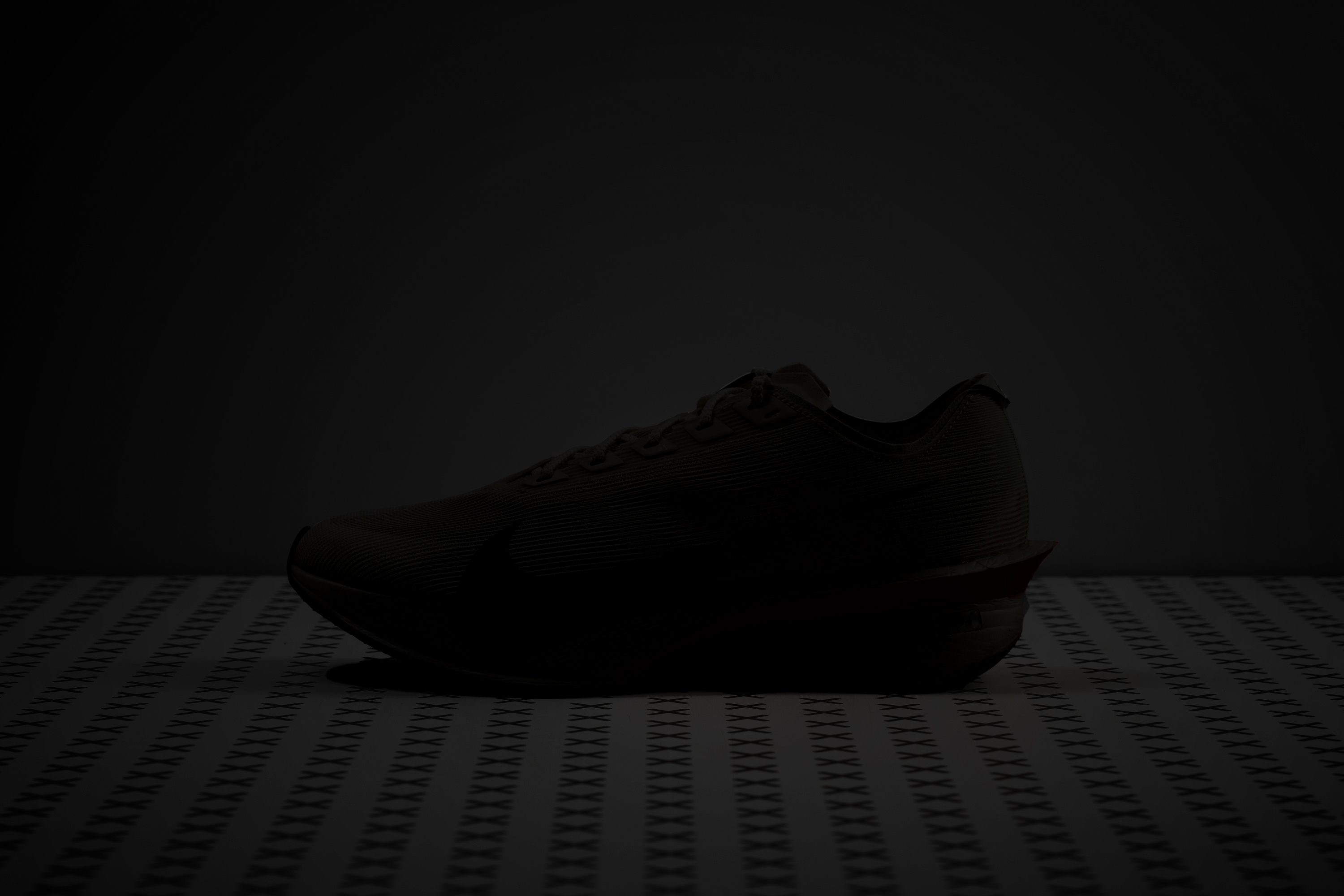
| Vaporfly 4 | No |
Acolchado de la lengüeta
La lengüeta es una de esas zonas en las que Nike se acercó peligrosamente a los límites para reducir el peso al máximo. Además, es una actualización muy importante, ya que muchos corredores se quejaron de que la lengüeta de la v3 les hacía daño por ser demasiado grande y por ese diseño descuidado. Así que, nada, ¡ya está solucionado!
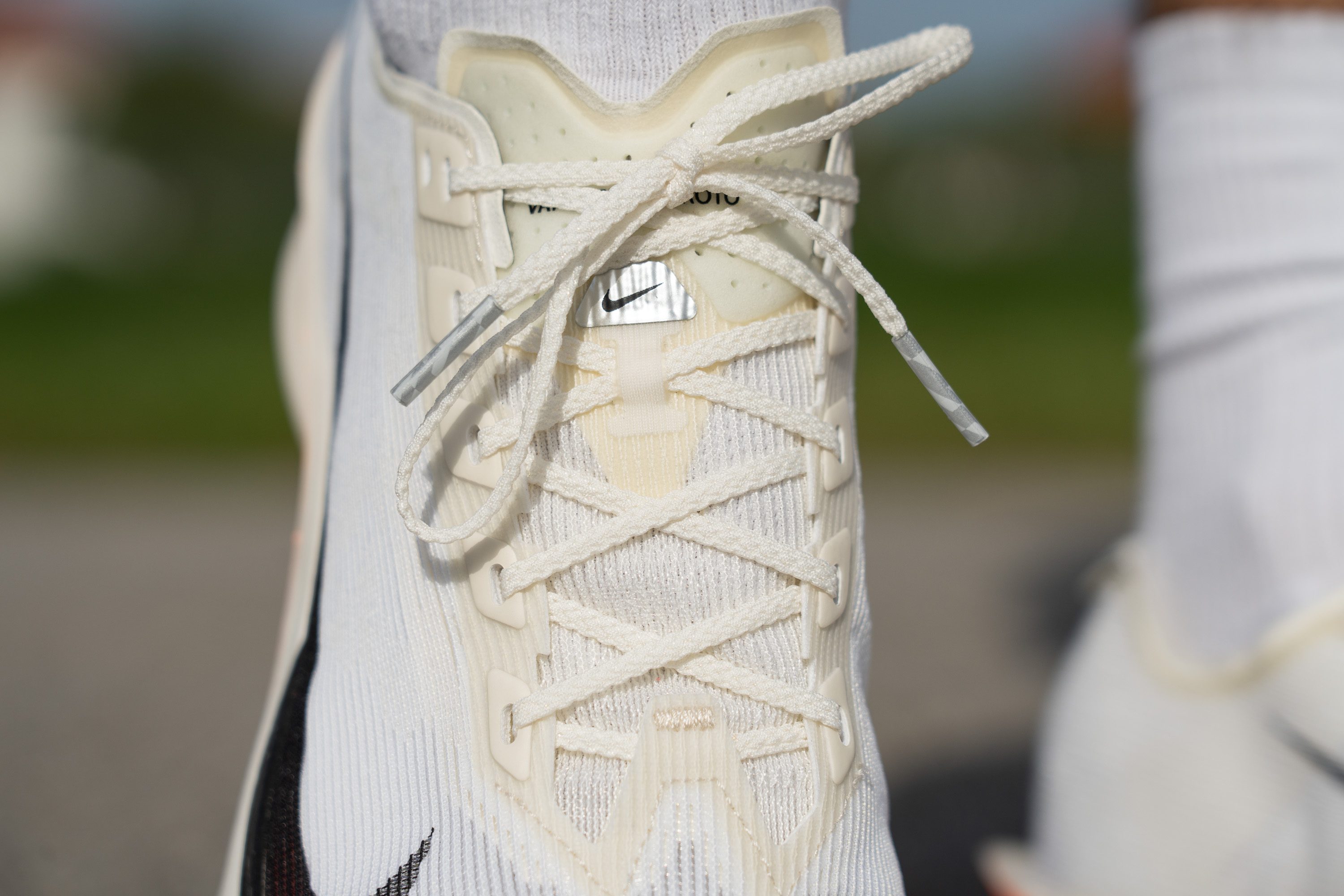
En las Vaporfly 3, la lengüeta tenía un grosor uniforme de 2,5 mm pero, en esta versión actualizada, Nike ha utilizado una lengüeta tan finita como un folio y tan ligera como una pluma, a la que se le suma una almohadilla de espuma pequeñísima de 2,5 mm para proteger el empeine justo donde se atan los cordones.
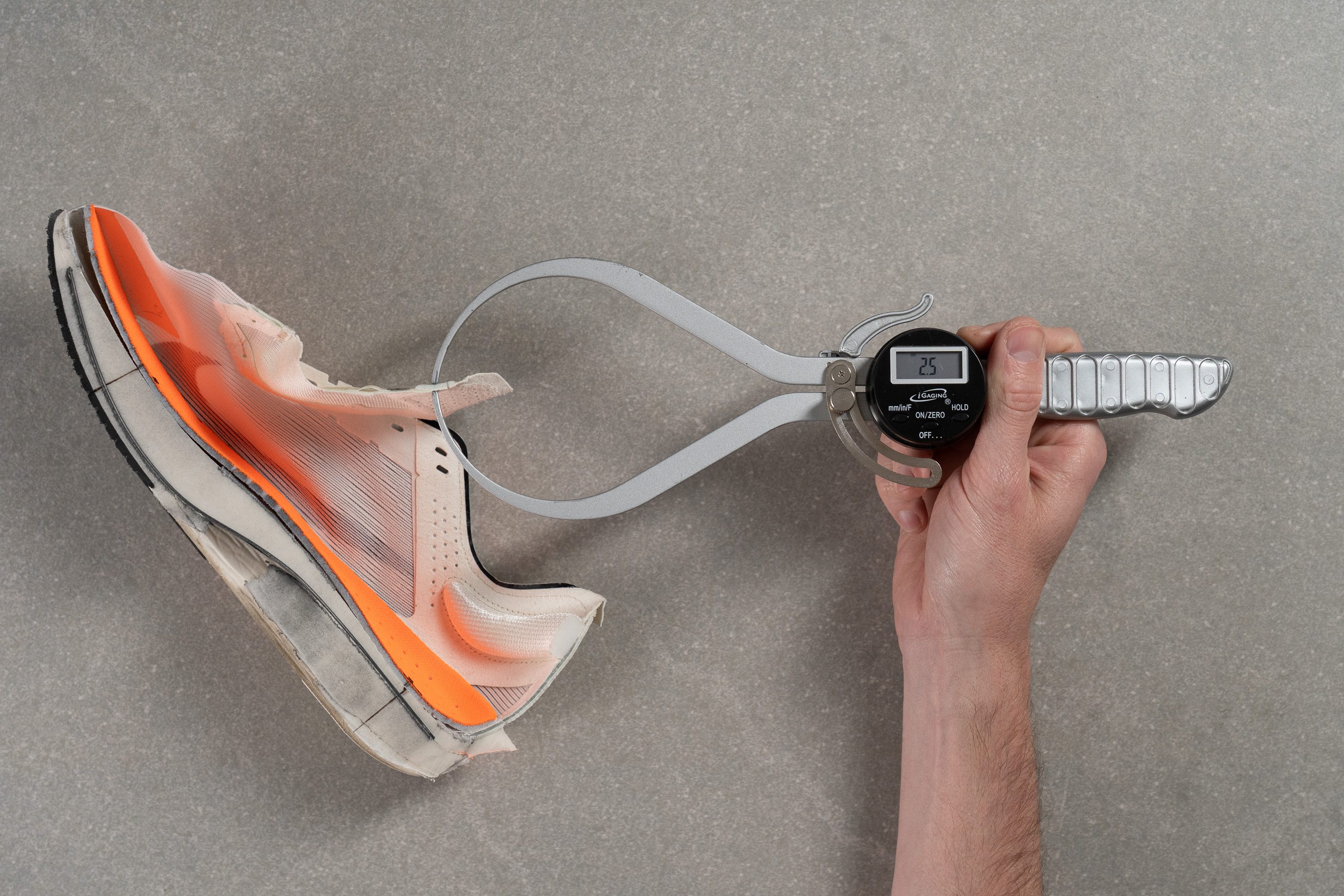
| Vaporfly 4 | 2.5 mm |
| Media | 5.8 mm |
Lengüeta: tipo de refuerzo
Como la mayoría de las superzapatillas, la lengüeta se puede mover libremente, ya que no está sujeta a los laterales. Sin embargo, gracias al ajuste seguro, creemos que no debería causarles ningún problema a la mayoría de los corredores.

| Vaporfly 4 | Ninguno |
Precio
El precio sigue siendo el mismo que el de los modelos anteriores, y creemos que es justo para las Vaporfly 4. De hecho, la mayoría de las marcas han ido subiendo los precios constantemente. En nuestra experiencia, una placa de carbono de gama alta, una estructura ligera y una potente mediasuela de espuma ZoomX no van a venir en unas zapatillas que sean una gana. ¡Las cosas claras y el chocolate espeso!
| Vaporfly 4 | $260 |
Tirador del talón
El talón se ha rediseñado por completo, y ya no tiene el tirador de las Alphafly 3. Ahora cuenta con otro que, más que un detalle funcional, parece algo meramente estético.
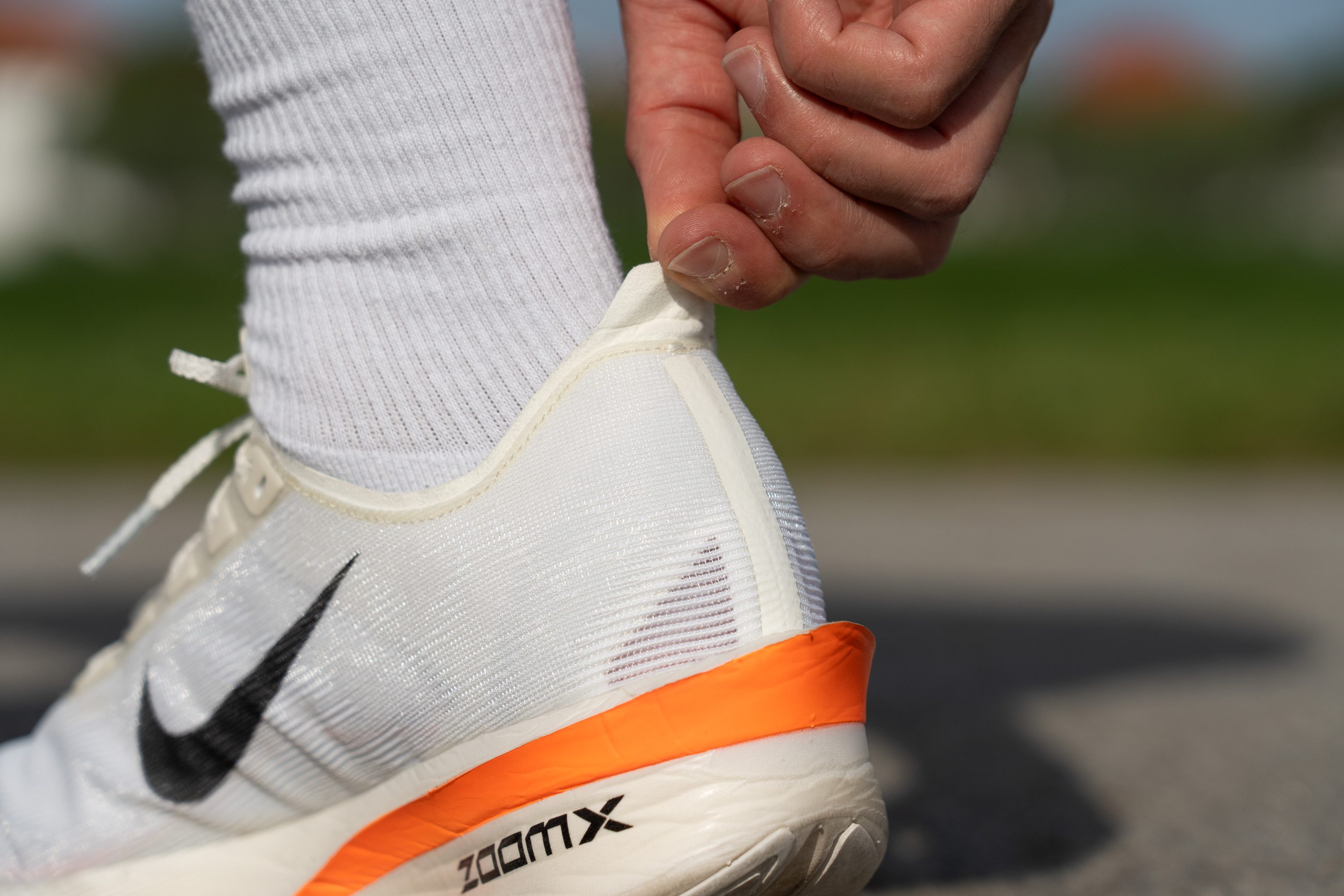
| Vaporfly 4 | Tirador estándar |

